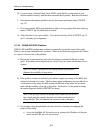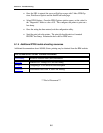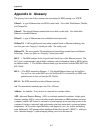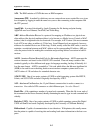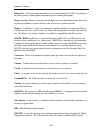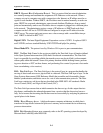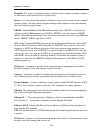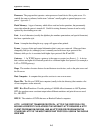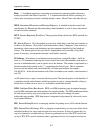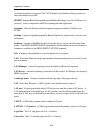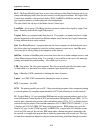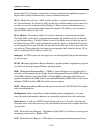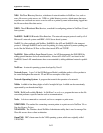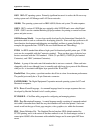
Appendix A: Glossary
A-6
Firmware. The program that operates a microprocessor-based device like a print server. Es-
sentially the same as software, but the term "software" usually applies to general-purpose com-
puters. Appendix C.
Flash Memory. A type of memory which allows read and write operations, but permanently
stores data when the power is turned off. Useful for storing firmware, because it can be easily
updated by downloading new code.
Font. A set of characters (usually the alphabet plus numbers punctuation, and special characters)
that have a particular style.
Form. A template describing the way a page will appear when printed.
Frame. A group of data and control information that is sent over a network. Often used inter-
changeably with packet, although frame is normally used with lower-layer protocols like
Ethernet, while packet is associated with higher layer protocols like IP and IPX.
Gateway. 1. In TCP/IP jargon, a gateway is the same as a router (see Router). 2. A device
that converts one higher-level network protocol to a different higher level protocol (for example, a
LAT-to-TCP/IP gateway).
Hops. The number of routers that are located between two devices, such as the print server and
the file server.
Host Computer. A computer that provides services to one or more users.
Hosts File. The file on a UNIX host computer (usually in the /etc directory) that contains a list
of host computers on the network).
HPT. Host Print Transform. Provides printing of AS/400 office documents to ASCII printers.
HPT also produces more consistent output when different emulators and print drivers are used.
Ex., HP4 PDT
HP/UX. The variation of UNIX that runs on Hewlett-Packard computers.
HTTP. HYPERTEXT TRANSFER PROTOCOL. HTTP IS THE PROTOCOL FOR
MOVING HYPERTEXT FILES ACROSS THE INTERNET. HTTP REQUIRES A HTTP
CLIENT PROGRAM ON ONE END, AND AN HTTP SERVER PROGRAM ON THE
OTHER END. HTTP IS THE MOST IMPORTANT PROTOCOL USED IN THE WORLD
WIDE WEB



